Dry, cracked feet are more than just an eyesore—they are painful! Once you find yourself battling a cracked heel, you can feel it with every step (trust me; I know). Thankfully, there are plenty of cracked heel remedies that work wonders in restoring the softness and smoothness of your precious soles—even overnight.
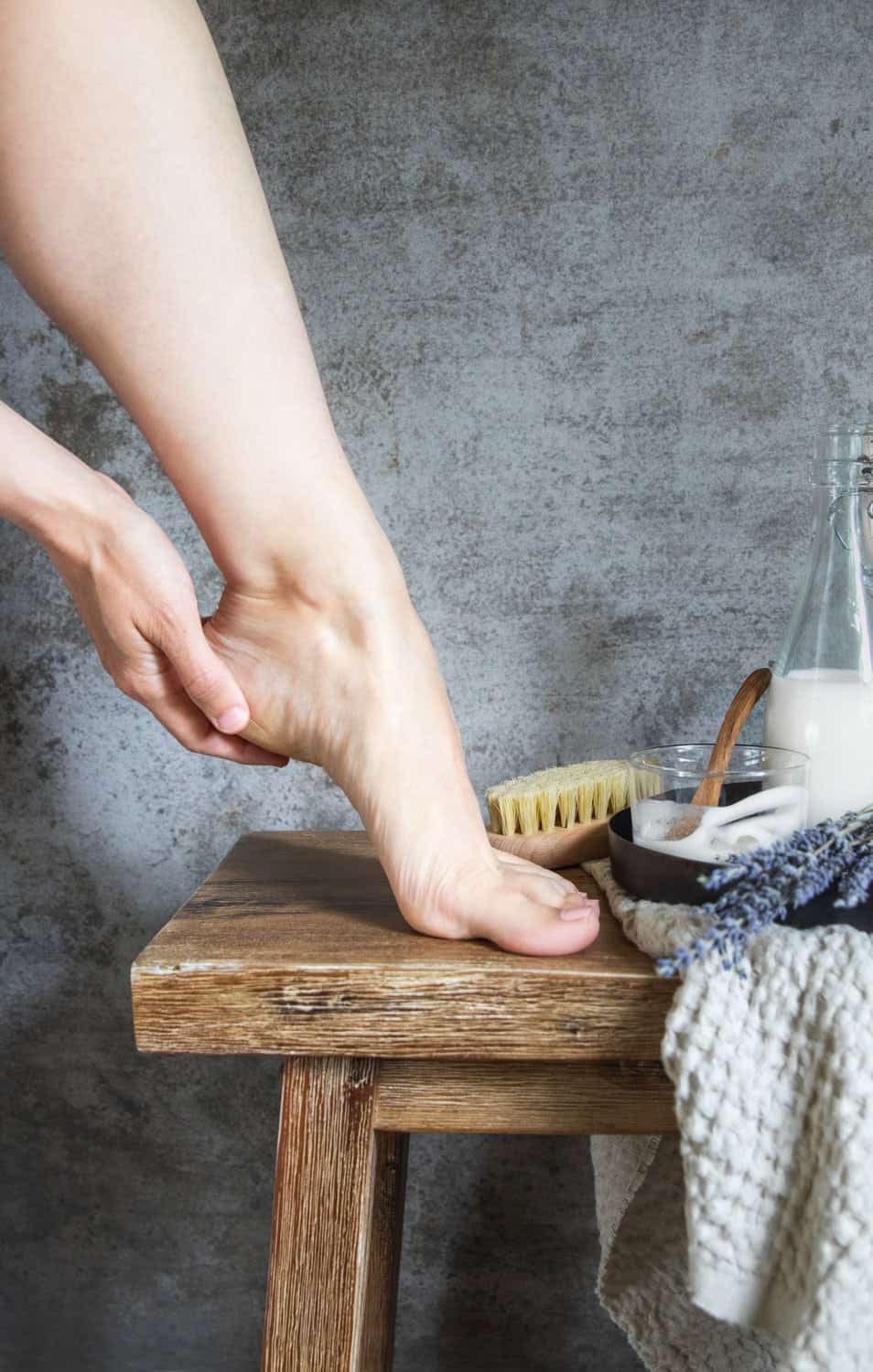
I came up with this recipe because I always get heel cracks after a trip to the beach—a week of salty dryness plus the wear and tear of walking barefoot on hot sand takes a toll! When I get home my feet are in serious need of TLC, but after a few nights soaking, scrubbing, and applying this mega moisturizing healing balm they're back to feeling baby soft!
Jump to:
Ingredients
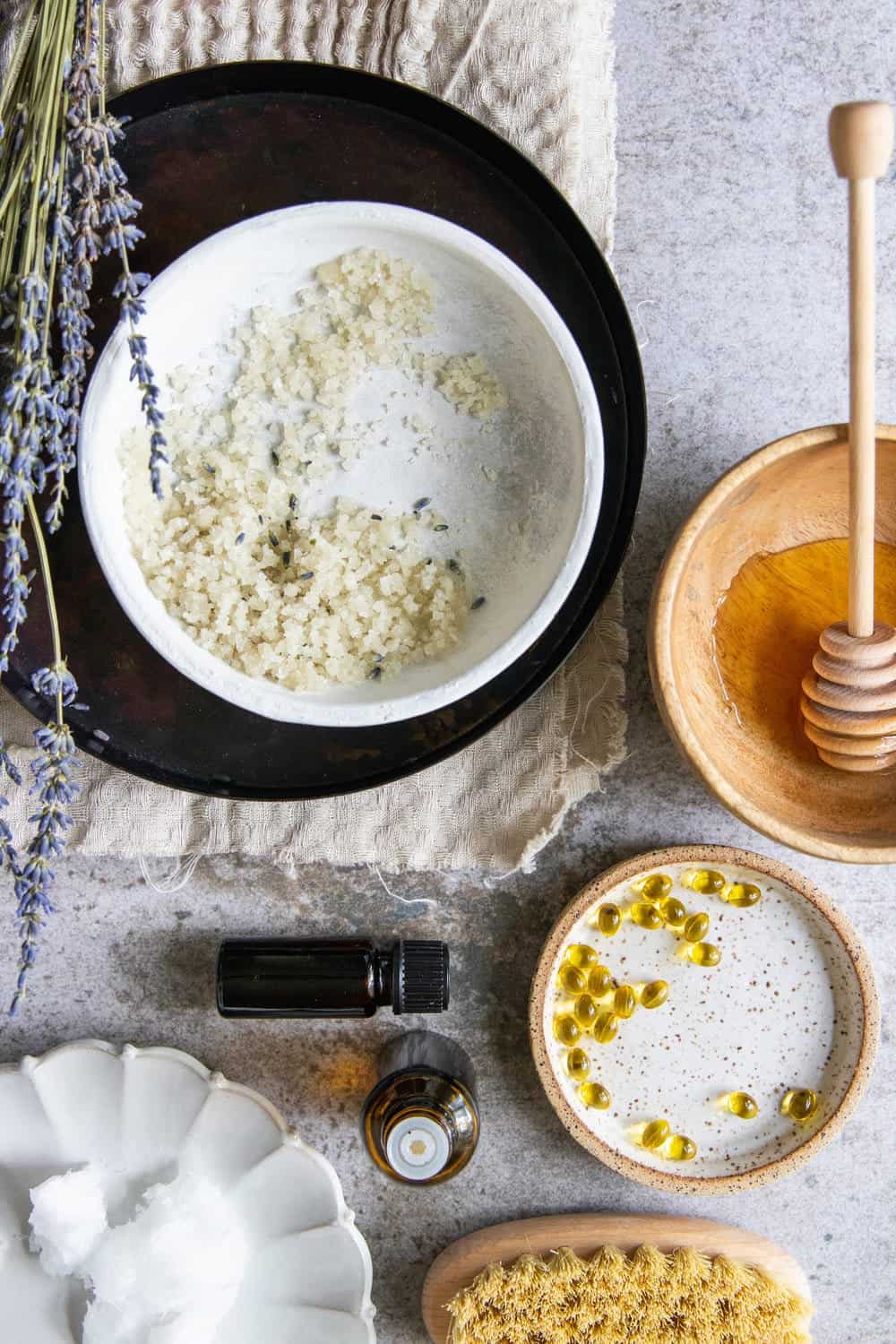
Shea butter — Shea butter is rich in fatty acids, including oleic, stearic, and linoleic acids, which help moisturize and nourish dry skin. When applied to cracked heels, it helps to hydrate the skin, improving its elasticity and promoting healing.
Coconut oil — When it comes to cracked heels, coconut oil is a godsend. Thanks to its high fat content, coconut oil helps replenish lost moisture, soften the skin, and improve the skin's elasticity [source]. Regularly massaging coconut oil onto the heels can leave the skin feeling smoother, more hydrated, and less prone to cracking.
Olive oil — With its rich, emollient properties and nourishing vitamins and minerals, olive oil makes a great cracked feet treatment. It's a natural anti-inflammatory that deeply moisturizes the skin and softens rough patches [source].
Vitamin E oil — Vitamin E oil is a potent antioxidant that helps nourish and repair the skin [source]. Applying vitamin E oil to cracked heels can provide deep hydration, promote healing, and improve the overall condition of the skin.
Lavender essential oil— Lavender is well known for its antibacterial and antifungal effects [source]. Lavender essential oil can help alleviate inflammation, moisturize the skin, and promote healing, making it an ideal choice for soothing and revitalizing cracked feet.
Tea tree essential oil — Renowned for its antimicrobial and antifungal properties [source]. It also has a refreshing and cooling effect, providing relief from discomfort and aiding in the healing process.
Peppermint essential oil — The cooling sensation provides immediate relief to dry, cracked feet. It helps soothe irritation, moisturize the skin, and improve circulation [source], making it an invigorating choice for revitalizing tired, cracked feet.
See recipe card for quantities.
Instructions
The three tenets of healthy skin are: soften, exfoliate, and moisturize. If you're looking to give your cracked heels some extra care and attention, you can do this simple 3-step pedicure at home for cracked heels once or twice a week.
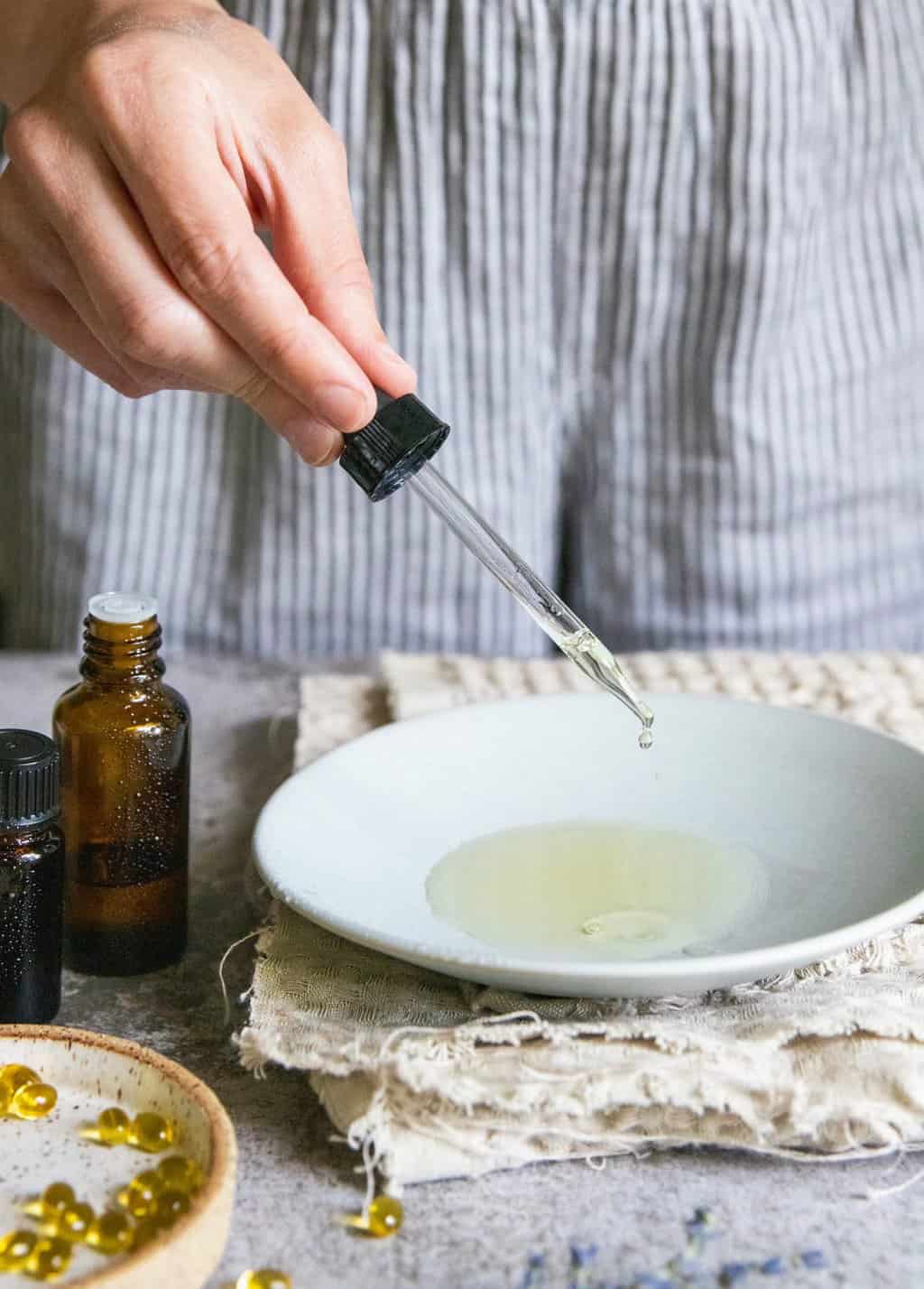
Make your heel balm - In a double boiler or microwave-safe bowl, melt the shea butter and coconut oil completely.
Remove from the heat and let the mixture cool for a few minutes before adding the sweet almond and essential oils. Stir well to combine.
Transfer the mixture to a clean, airtight container or jar, and allow it to cool completely.
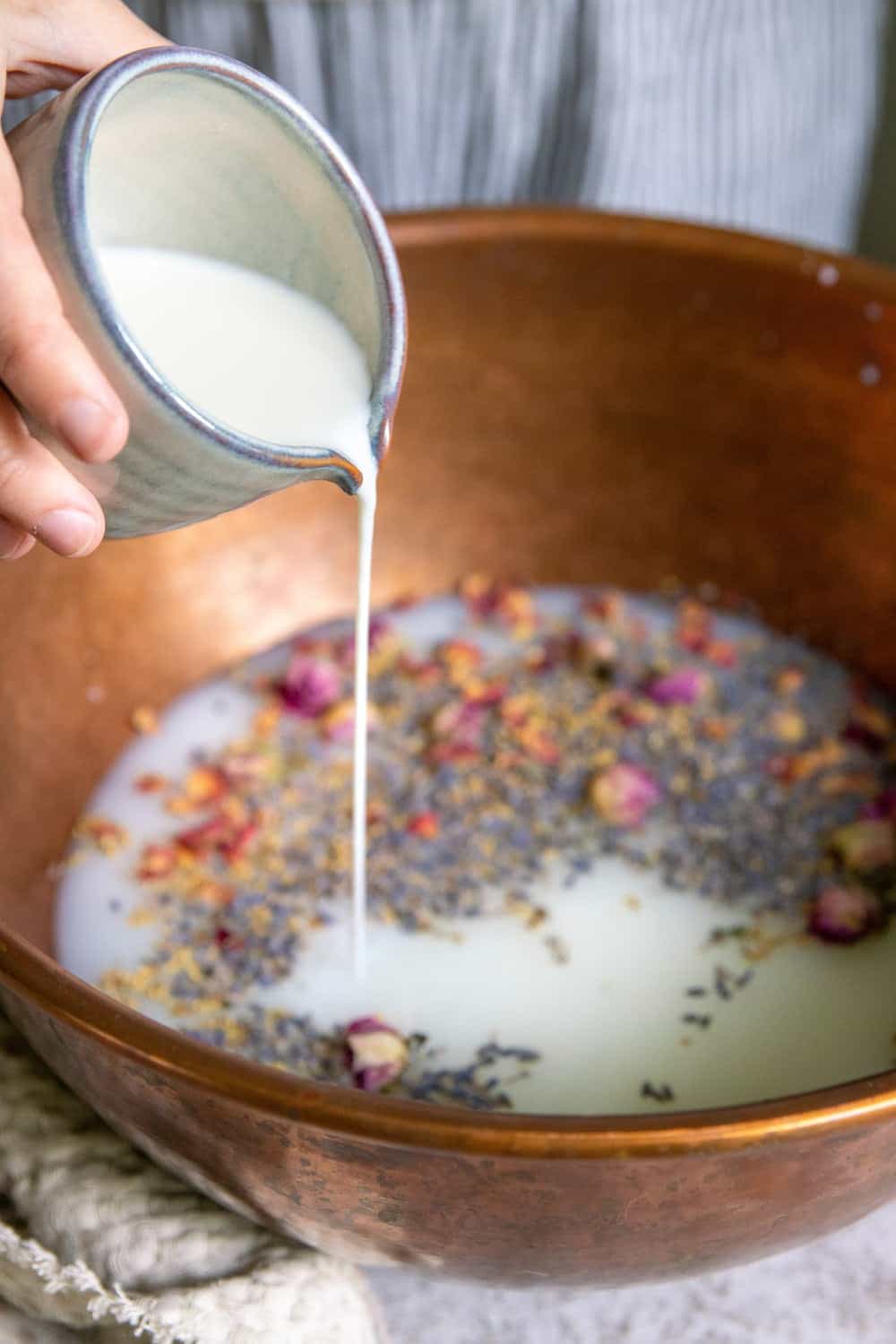
Soften with a foot soak - Regularly soaking your feet in warm water helps to soften the skin, making it less prone to cracking in the first place.
Fill a basin with warm water and add ½ cup Epsom salt, ½ cup whole milk, and 10 drops of essential oil. Soak your feet for 15–20 minutes.
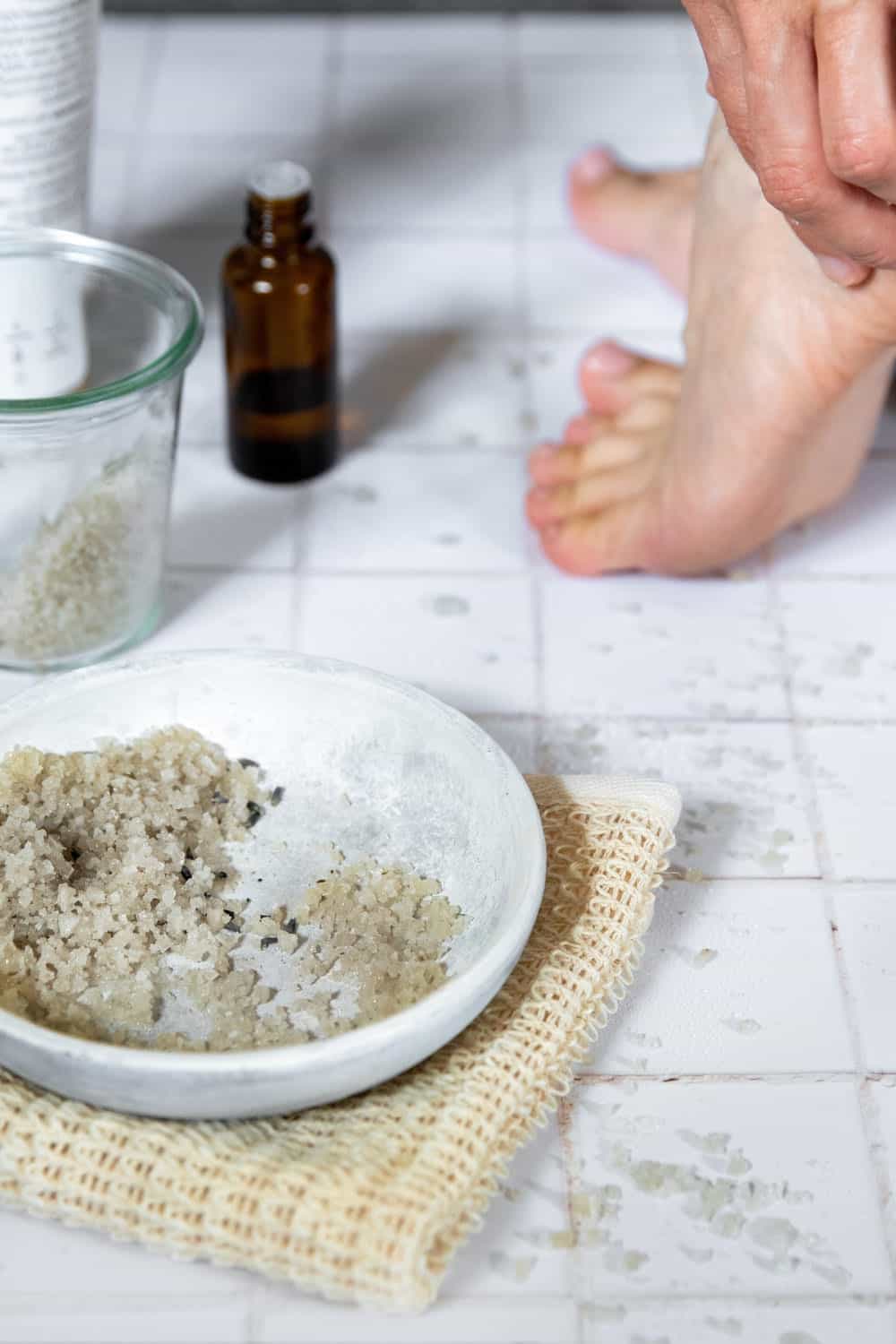
Exfoliate with a foot scrub — Exfoliating the feet, either with a salt scrub or a pumice stone, sloughs away dead skin cells and rough patches on tough soles, leaving your feet smoother and more receptive to the nourishing benefits of a moisturizing balm.
Combine 2 tablespoons sea salt and 1 tablespoon olive oil. Gently massage the scrub onto your feet then rinse with warm water and pat dry.

Moisturize with cracked heel balm — Apply 1 teaspoon of this heavy-duty moisturizer that's rich in emollients and humectants to each foot to seal in moisture, soften rough skin, and prevent the formation of cracks.
Hint: For best results, apply the foot cream before bed, and wear a pair of clean cotton socks overnight to lock in the moisture. Repeat daily to help heal and prevent dry, cracked heels.
Substitutions
This foot cream recipe can be customized by trying different carrier oils or essential oils known for their skin-nourishing properties. Just make sure to maintain the same ingredient ratios when making replacements.
- Neem oil — Neem oil is derived from the neem tree and has antimicrobial and moisturizing properties [source]. Apply a few drops of the oil directly to your cracked feet and massage it into the skin. Leave it on overnight and rinse off in the morning for its healing and hydrating effects.
- Sesame oil — Sesame oil is deeply moisturizing, and turmeric possesses anti-inflammatory properties [source] that can help to heal cracked feet.
- Frankincense essential oil — Frankincense works wonders on the skin, so why not use it on your feet as well? It helps promote cell regeneration, supports the healing process [source], and enhances the overall appearance and texture of the skin on the feet.
Always perform a patch test before applying the heel cream to ensure you do not have any adverse reactions to the ingredients.
Variation
If you have no time for the full pampering pedicure, you don't have to miss out on the healing benefits of essential oils for your feet. Try one of these variations to soothe and hydrate dry skin:
- Compress — For a foot soak without the mess mix 5–10 drops of essential oil with some warm water. Then soak a clean cloth or towel in the mixture. Wring out the excess liquid and apply the warm compress to your cracked feet for soothing relief.
- Aloe vera lotion — Aloe has long been used for its soothing and hydrating properties and its benefits for healing skin [source]. Blend essential oils with aloe vera gel to create your own cracked heels lotion to alleviate dryness and reduce inflammation.
- Calendula salve — DIY this natural calendula salve that's soothing and anti-inflammatory [source] and apply it to your cracked heels regularly. It helps moisturize, nourish, and promote the healing of damaged skin.
- Shea butter foot mask — Whip up a single use overnight mask with 1 tablespoon shea butter, 1 teaspoon vitamin E oil, 6 drops of frankincense essential oil. Mix the shea butter and oils in a small bowl until smooth. Massage the balm onto your feet and wear socks overnight to allow the balm to deeply penetrate and moisturize your feet.
- Heel massage — Even easier, just combine a carrier oil such as coconut, almond, or jojoba oil with one of recommended essential oils and enjoy a foot massage. The recommended dilution ratio is typically 2–3% for adults. For example, add 6–9 drops of essential oil to every 1 ounce (30 mL) of carrier oil.
Storage + Equipment
Use a clean, airtight 4-ounce jar for your heel balm and store it in a cool, dry spot. It should last 6 months.
While you're pampering your feet, don't forget your hardworking hands. Get all the tools you need, and learn the best techniques for an at-home manicure to keep your hands and nails soft and smooth.
Top tip
Cover your feet with clean socks to enhance the absorption of the oils and lock in moisture. Leave the socks on for at least 30 minutes (overnight is even better!) to allow the oils to work their magic. If applying during the day, you may want to put on open-toed shoes to prevent excess moisture buildup.

FAQ
Some effective natural remedies for cracked heels include:
—Regularly exfoliating the heels to remove dead skin.
—Soaking the feet in warm water with added ingredients like Epsom salt or apple cider vinegar.
—Applying natural moisturizers like shea butter, coconut oil, or olive oil to keep the skin hydrated.
Essential oils can help soothe cracked heels in several ways. Lavender oil has soothing and healing properties. Tea tree oil has antifungal and antimicrobial properties. Peppermint oil provides a cooling sensation and can help relieve pain and inflammation.
You can apply the homemade heel balm once or twice a day, depending on the severity of your cracked heels. Apply it after washing and drying your feet to maximize absorption and moisture retention.
Yes, there are a few lifestyle changes that can help prevent cracked heels:
—Moisturize your feet regularly, especially after bathing or showering.
—Wear well-fitting, comfortable shoes that provide proper support.
—Avoid walking barefoot on hard surfaces.
—Drink an adequate amount of water to keep your body and skin hydrated.
—Maintain a balanced diet rich in vitamins and minerals that support skin health.
There are various essential oil combinations you can try for cracked heels.
Try lavender and tea tree oil: Lavender helps soothe and heal the skin, while tea tree oil has antimicrobial properties to combat infections.
Lotion recipes
Show your skin some love with homemade lotion recipes:
Soothing Shea Butter Cracked Heel Balm
Materials
- ¼ cup shea butter
- 2 tablespoons coconut oil
- 1 ½ tablespoons olive oil
- 1 teaspoon vitamin E oil
- 16 drops lavender essential oil
- 14 drops tea tree essential oil
- 6 drops peppermint essential oil
Instructions
- In a double boiler or microwave-safe bowl, melt the shea butter and coconut oil completely.
- Remove from the heat and let the mixture cool for a few minutes before adding the olive oil, vitamin E, and essential oils. Stir well to combine.
- Transfer the mixture to a clean, airtight container or jar, and allow it to cool completely.
- To use, take a small amount (½ to 1 teaspoon) and gently massage it into your cracked heels and feet, focusing on the areas that need extra care.
- For best results, first soak and scrub your feet, then apply the foot cream before bed. Wear a pair of clean cotton socks overnight to lock in the moisture. Repeat daily to help heal and prevent dry, cracked heels.
References
- Lin TK, et al. Anti-inflammatory and skin barrier repair effects of topical application of some plant oils. Int J Mol Sci. 2017.
- Alzohairy MA. Therapeutics role of Azadirachta indica (neem) and their active constituents in diseases prevention and treatment. Evid Based Complement Alternat Med. 2016.
- Keen MA, et al. Vitamin E in dermatology. Ind Dermatol Online J. 2016.
- Behmanesh F, et al. Antifungal effect of lavender essential oil (Lavandula angustifolia) and clotrimazole on Candida albicans: an in vitro study. Scientifica (Cairo). 2015.
- Sharifi-Rad J, et al. Biological activities of essential oils: from plant chemoecology to traditional healing systems. Molecules. 2017.
- Zhao H, et al. Peppermint essential oil: its phytochemistry, biological activity, pharmacological effect and application. Biomed Pharmacother. 2022.
- Orchard A, et al. Commercial essential oils as potential antimicrobials to treat skin diseases. Evid Based Complement Alternat Med. 2017.
- Srivastava JK, et al. Chamomile: a herbal medicine of the past with bright future. Mol Med Report. 2010.
- McLoone P, et al. Honey: a therapeutic agent for disorders of the skin. Cent Asian J Glob Health. 2016.
- Hekmatpou D, et al. The effect of aloe vera clinical trials on prevention and healing of skin wound: a systematic review. Iran J Med. Sci. 2019.
- Arora D, et al. A review on phytochemistry and ethnopharmacological aspects of genus Calendula. Pharmacogn Rev. 2013.

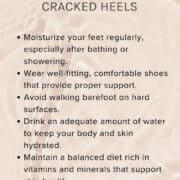
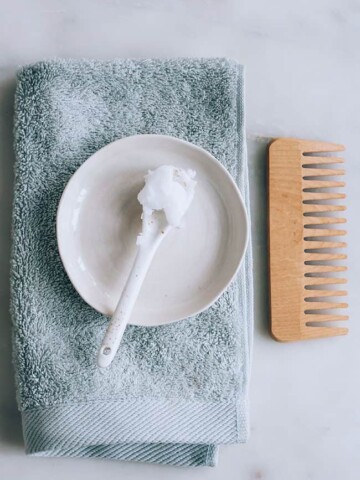
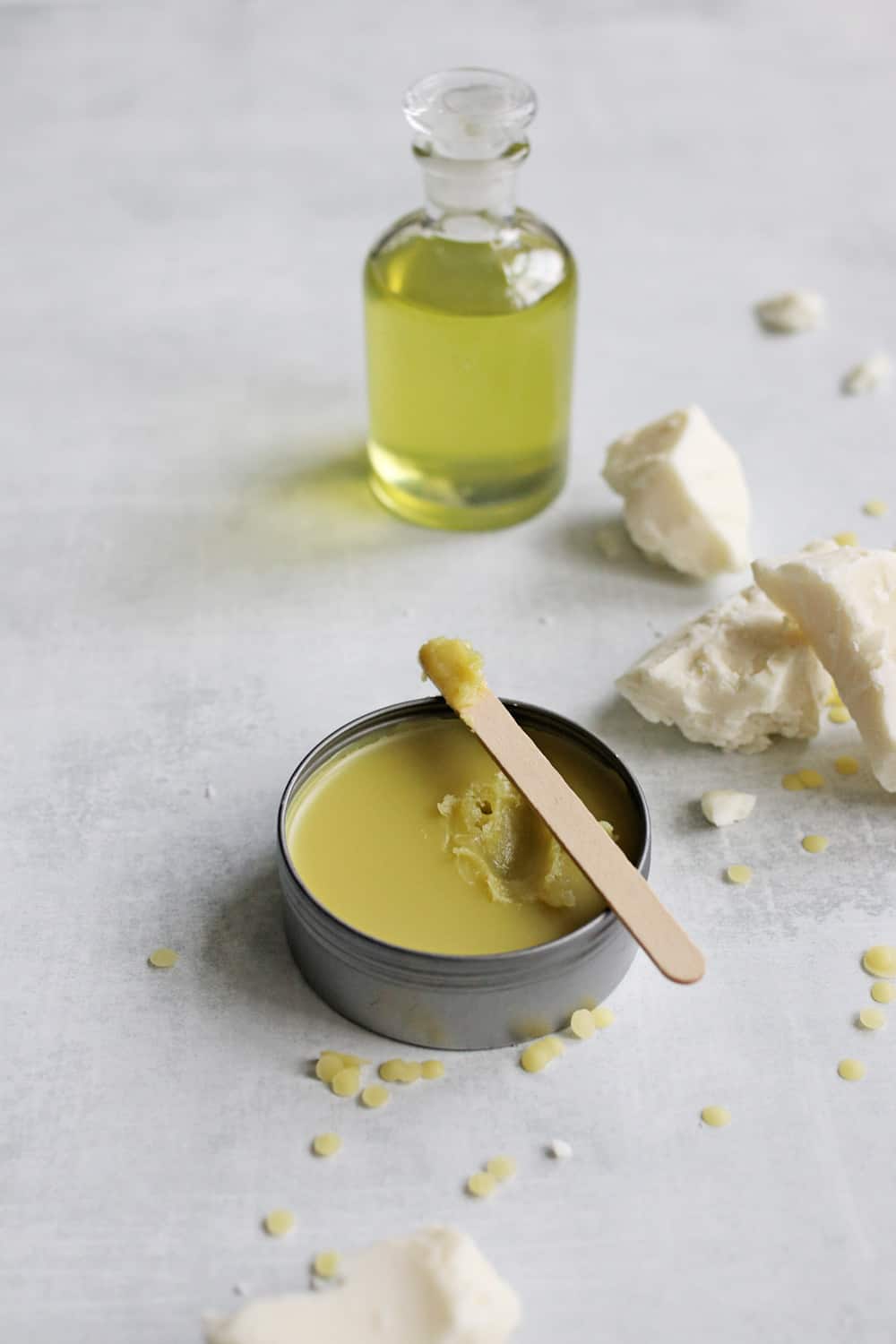
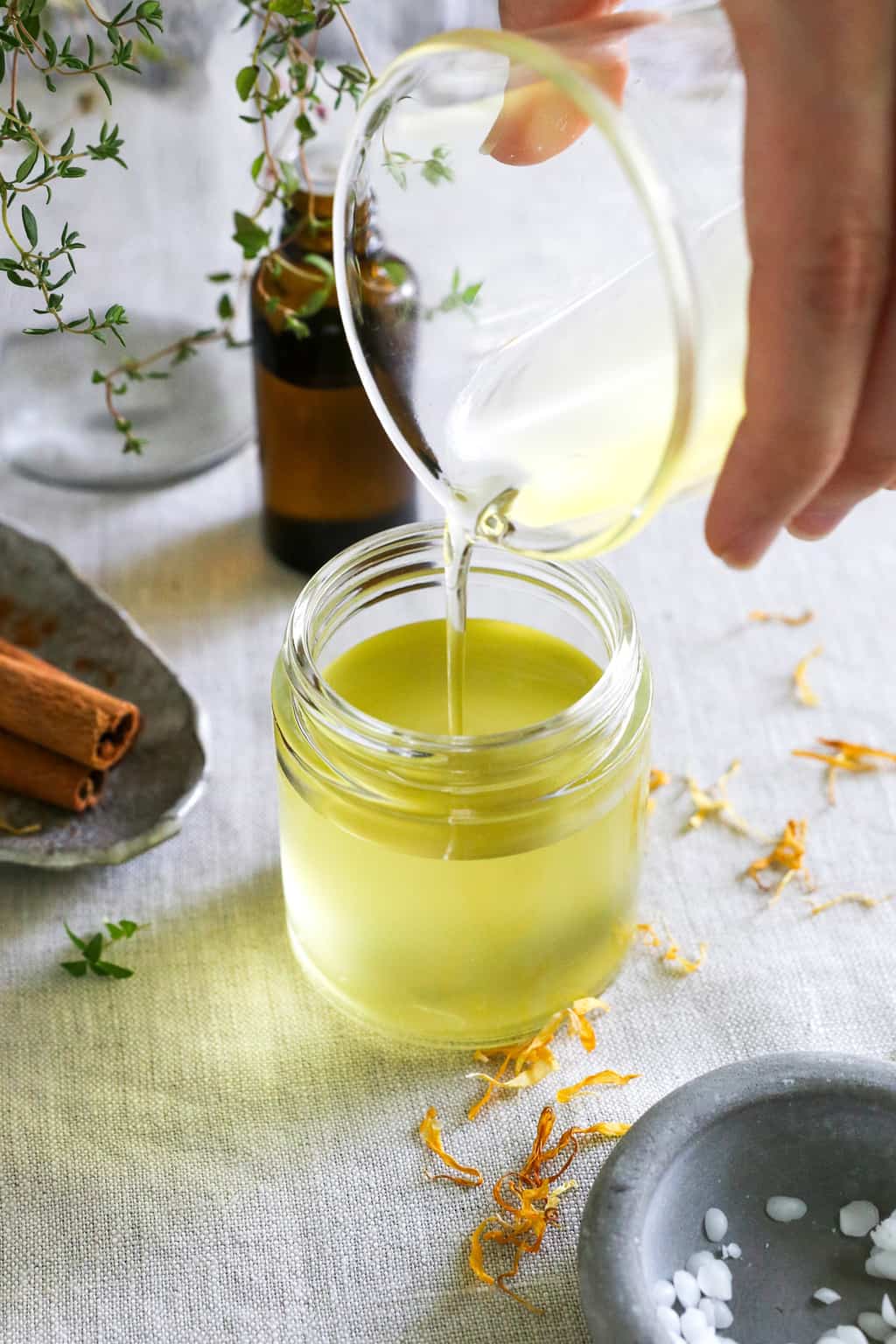
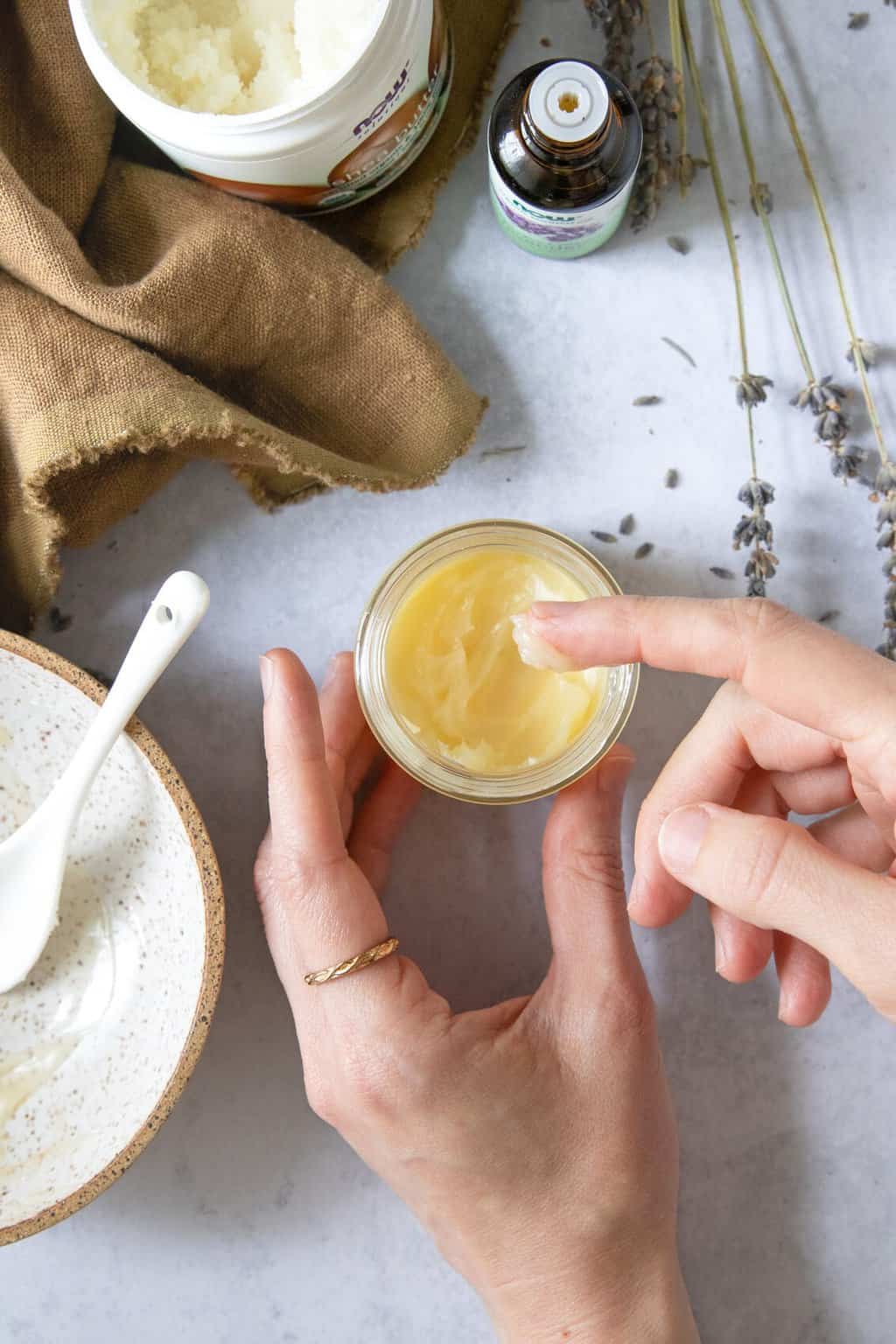
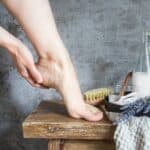

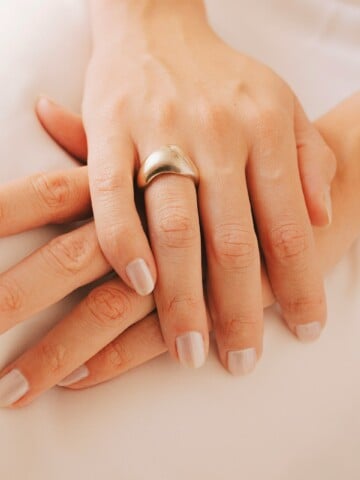
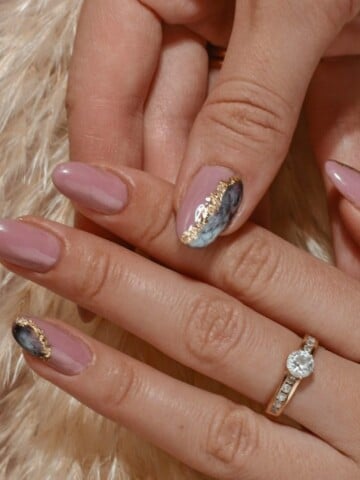

Leave a Comment